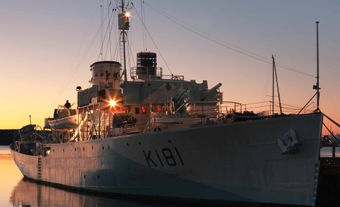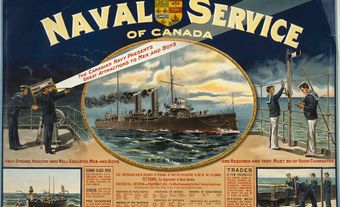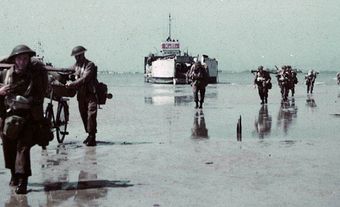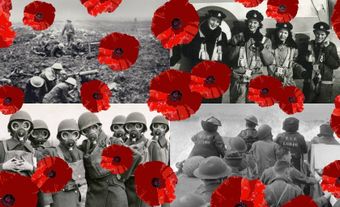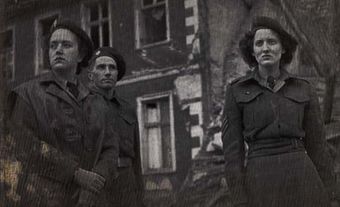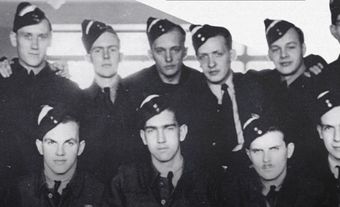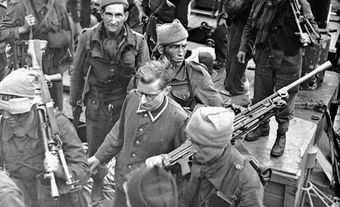Corvettes were small, lightly armed Canadian-built warships used for anti-submarine warfare in the Second World War. With the threat by German U-Boats to convoys on the North Atlantic from the outset of the war, Canada needed to produce ships quickly. The answer was the corvette, a vessel of barely 1,000 tonnes and about 63m long. Construction began early in 1940 and the first 14 appeared in the St Lawrence in the last months of the year. In total, Canada’s 111 corvettes comprised a quarter of its combat fleet; ten of those were lost in action.

Flower-class Corvette Specifications
|
|
Original (1939–40)
|
Modified (1941–44)
|
|
Displacement
|
950 tonnes
|
1,015 tonnes
|
|
Length
|
62.5 metres
|
63.4 metres
|
|
Beam
|
10 metres
|
10 metres
|
|
Draught
|
3.5 metres
|
3.5 metres
|
|
Maximum Speed
|
16 knots
|
16 knots
|
|
Endurance
|
3,500 nautical miles at 12 knots
|
7,400 nautical miles at 10 knots
|
|
Crew
|
75
|
87
|
|
Armament
|
1 x 4-inch (100mm) gun on foredeck
|
1 x 100mm gun on foredeck
|
Context
The corvette was the mainstay of Canada’s naval effort in the Second World War and played a crucial role in the Battle of the Atlantic. When the Second World War began, the Royal Canadian Navy (RCN) consisted of only 13 ships: a half-dozen frontline River-class destroyers, four modern Fundy-class minesweepers, a pair of Battle-class trawlers left over from the First World War, and a sail training vessel. By the end of the war, it was the fourth-largest allied fleet (behind the United States, United Kingdom and Soviet Union), with nearly 100,000 men and women in uniform, and over 400 warships in commission — 111 of which were Flower-class corvettes.
Design and Construction
Canadian naval staff faced a problem in fall 1939: what kind of vessel should they get, and from where? Warship types like aircraft carriers, battleships, cruisers and destroyers were beyond the capacity of Canadian shipyards, and major British yards were already at capacity building these types. Moreover, at the time, there was no lend-lease arrangement with the (then neutral) United States.
But the Royal Navy (RN) had developed a type of auxiliary coastal escort that could be built in smaller British yards. This “patrol vessel, whale-catcher” was allegedly redesignated the “corvette” by Sir Winston Churchill, who then was First Lord of the Admiralty (before he became prime minister in May 1940). More famously, he dubbed them “cheap and nasties.” By the end of the war, the corvette was one of the largest Allied shipbuilding programmes: a total of 368 ships of eight different sub-types were built in Britain (186), Canada (122) and Australia (60).
The vessel was an adaptation of a commercial design that was inexpensive and easy to produce. The single-screw steel hull ship was small, at 62.5m long and 950-tonne displacement. Importantly, it could be built at most Canadian shipyards, which until then had never built a steel-hulled warship greater than 30m in length. Moreover, anything built in Canadian shipyards on the Great Lakes had to be shorter than 82m to fit through the locks on the St Lawrence River and Welland Canal (this changed when the Seaway was completed in the mid-1950s). The corvettes were equipped with two low-pressure boilers that provided steam to a 2,750-horsepower four-cylinder engine, giving the ships a range of 3,500 nautical miles at 12 knots (2,500 nautical miles at maximum speed of 16 knots).
Flower-class Corvettes
Ship classes generally are known by the name of the lead ship, that is, the ship that was first built. The first RN ship of the class was HMS Gladiolus, which was completed in April 1940. As all the RN vessels were given similar names, the corvettes become known as the Flower class. This was true in the RCN as well, although only the first 10 Canadian corvettes had “flower” names; the remainder were named after cities and towns on the advice of the Chief of the Naval Staff who observed that “flowers don’t knit mittens!”
Did you know?
Naming corvettes after flowers displayed the British sense of humour. Churchill thought that having one of Hitler’s sea wolves (U-boats) “destroyed by a vessel named for a flower, like HMS Buttercup” would be seen as an embarrassment for the Nazis and a public relations victory for the British.
The initial Canadian order of 54 corvettes under the 1939–40 program was completed as offshore auxiliary minesweepers with a wider quarterdeck, giving them a broader stern than the duck-tail shape of RN corvettes. Corvettes built in the 1940–41, 1942–43
and 1943–44 programs dropped the minesweeping capability.
Other changes to the basic design were made as the war continued. By October 1940, when the first Canadian-built corvettes were commissioned, Hitler’s forces had established U-boat bases within easy reach of the North Atlantic; this shifted the need for escorts to the open ocean. By then, corvettes were already notorious for their tendency to roll, and service on the open ocean quickly demonstrated the need to enclose the open well deck just forward of the bridge.
The corvettes were therefore modified in 1940–41 to extend the fo’c’sle aft, forming an enclosed deck from the new flared bow back in line with the funnel. This meant that the forward 4-inch (100mm) gun and the bridge had to be raised a full deck; eventually, the foremast was also moved from in front of the bridge to behind it. The changes dramatically altered the appearance of the later ships. Earlier-built ships were eventually modified to this configuration as operational requirements and shipyard capacity allowed; for example, Sackville from the original program was commissioned in December 1941, and was refitted in February-May 1944 (one of the last to be modified).

Changes were also made to the corvettes to increase operating range, which was limited in the early ships. From 1942 to 1944, corvettes were fitted with a more compact and efficient boiler type that allowed for additional fuel tanks, giving the ships a much-improved range of 7,400 nautical miles at 10 knots. From mid-1943, the Hedgehog mortar began to be fitted, offering greater accuracy in attacks against submarines.
Canadian radio equipment and refrigeration were better than British versions. Some major deficiencies remained, however, including the lack of a gyro compass for accurate navigation (the corvettes were fitted with magnetic compasses that did not follow “true” north and had a lot of swing in the bearings indicated). They were also outfitted with Canadian-designed radars and sonars that were not as accurate as later British developments. These deficiencies affected the corvette’s ability to conduct accurate attacks on submerged U-boats.
Deployment
Most RCN corvettes were allocated to the “North Atlantic Run”, but at various times nearly half of them were detached for such operations as the re-occupation of the Aleutians (August 1942), Caribbean convoys (October 1942–October 1943), the Battle of the Gulf of St Lawrence (summers of 1942 and 1944), Torch (the invasion of North Africa, November 1942–January 1943) and Neptune (offshore support for the invasion of Normandy, May–August 1944). Although 10 were lost in action, RCN corvettes participated in the capture or destruction, alone or in company, of 14 German U-boats.

Demobilization and Legacy
Within a year of the war’s end, most of the corvettes were sold for scrap; a few went to smaller Latin American and Asian navies. Only one, HMCS Sackville, remained in Canadian government service, as a civilian oceanographic research vessel with the Department of Transport until it was paid off in 1982. The volunteer Canadian Naval Memorial Trust was soon formed to acquire and restore the ship to its configuration as modified in mid-1944. In 1985, HMCS Sackville was designated as Canada’s Naval Memorial and dedicated to the 2,000 Canadian sailors who lost their lives at sea. The ship is berthed on the Halifax waterfront at the Maritime Museum of the Atlantic and is open to the public for tours.

 Share on Facebook
Share on Facebook Share on X
Share on X Share by Email
Share by Email Share on Google Classroom
Share on Google Classroom







